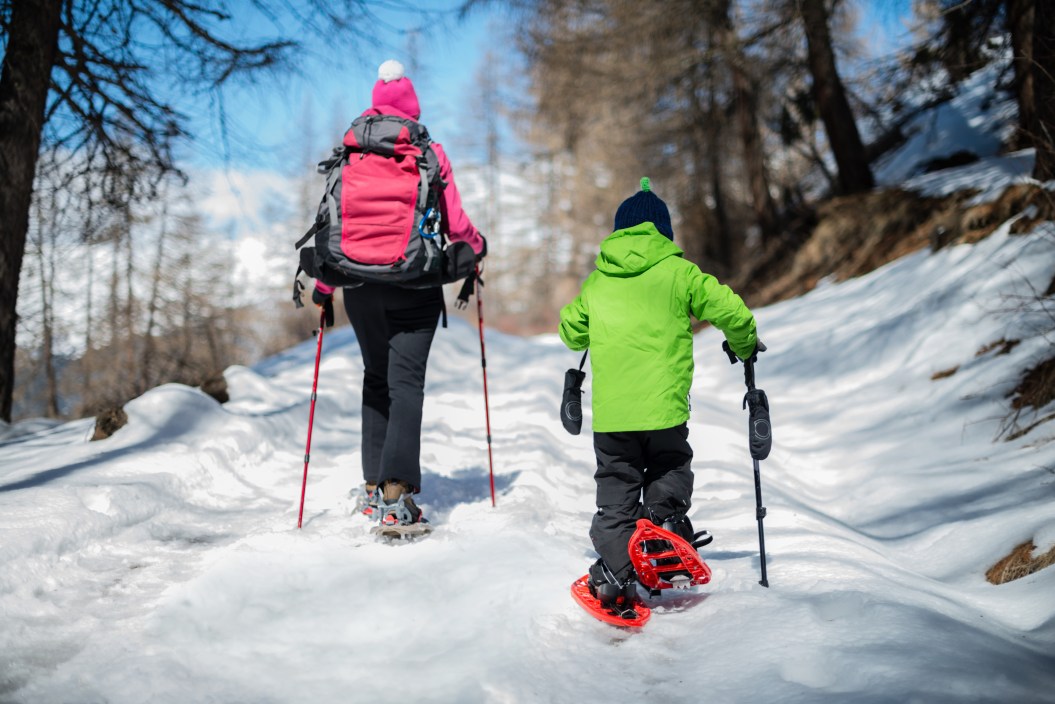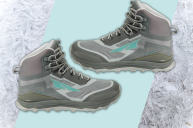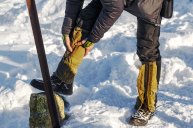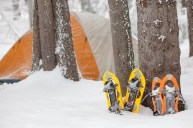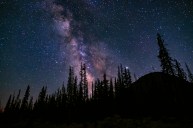Imagine the untouched beauty of rolling hills and evergreens blanketed in pristine white. The snow crunches beneath your feet yet you're floating from drift to drift—like walking on water, except it's frozen into zillions of six-pointed crystals covering everything as far as you can see. You're not dreaming—snowshoeing can makes this scene a reality for you.
My family and I are huge fans of this winter activity that allows us to enjoy nature and experience our favorite trails in a whole new way. Winter hiking is great, but hiking boots don't stand a chance on ice or in deep snow. That's where snowshoes and snowshoeing boots come in. But what exactly is snowshoeing? Read on for everything you need to know to get started.
What is Snowshoeing?
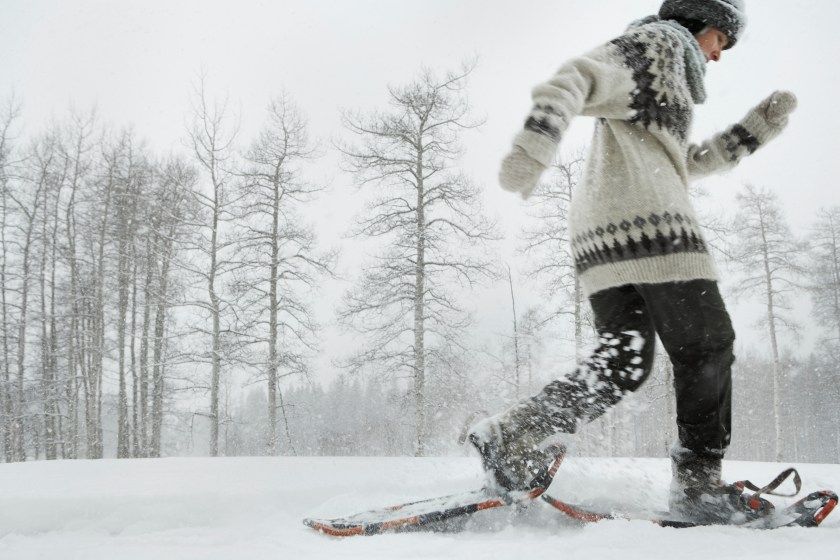
Getty Images, Thomas Northcut
Hiking is far more popular during the spring, summer, and fall when temperatures are more pleasant and the worst weather you might encounter is a downpour. And while winter hiking is possible and enjoyable, it can be slow-going over fresh snowfall and even dangerous if you're ill-equipped for the weather conditions. For those not opposed to the cold weather and looking for a potentially safer way to enjoy the great outdoors over the winter, showshoeing may be the alternative you're looking for.
Showshoeing involves strapping winter boots into snowshoes composed of wide decking that acts much like snow floatation devices for your feet. The larger surface area of the snowshoe gives the wearer support and balance for traversing snow without sinking too deeply into it.
The earliest snowshoes were made from hardwood and latticed rawhide. Newer styles are more sophisticated yet designed on the same basic principles. Typically, the frame is made of plastic or a lightweight metal with synthetic or fabric straps or velcro binding. Crampons, or spikes, attached to the shoe's base help you gain traction on steep slopes or slippery terrain. Depending on the difficulty of the trail and the comfort of the snowshoer, trekking poles are an option to help maintain balance or navigate tricky terrain and often come with a snowshoe rental or purchase.
Overall, snowshoeing is a fun recreational activity that anyone—no matter how young or old—can do.
Why to Try Snowshoeing
- It's beginner-friendly. Unlike winter sports like skiing, snowboarding, or skating that have a steep learning curve, snowshoeing's fundamentals are pretty much just putting one foot in front of the other. Snowshoers need to be aware of avalanche safety and winter survival skills before heading out into the snow. Always remember not to go off-trail. Beyond that, there are no specific skills or techniques to learn for basic snowshoeing.
- It's excellent exercise. Snowshoeing is a full-body workout, utilizing large and small muscles throughout your body, including some you probably didn't even know existed. (Trust me, you will the next day!) At first, it's more about building stamina than anything else. Once you become more advanced, you can learn uphill and downhill techniques.
- There's easy trail access. Many hiking trails at national and state parks turn into snowshoe trails (and cross-country skiing spots) in winter, making it easy to find a place to go snowshoeing. Ski resorts also have plenty of areas for trekking out on the snow.
- It's cheaper than some winter activities. As far as winter hobbies go, snowshoeing is relatively inexpensive. Most people who live in colder regions already have winter layers and boots, so first-time snowshoers will only have to rent or purchase a decent pair of snowshoes.
How to Pick Out Snowshoes
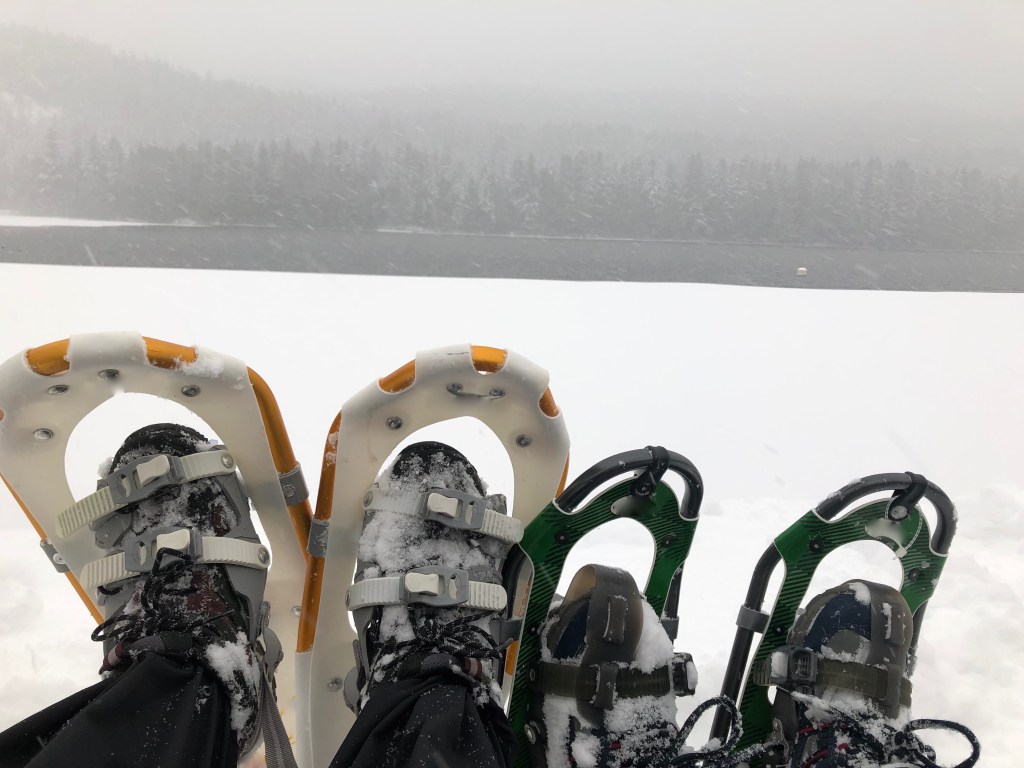
Getty Images, Denise Mackinnon
When shopping for snowshoes, it's critical is to select a pair that supports your body weight to ensure you'll stay on top of the snow, no matter how deep it may be. Snowshoes are worn over another pair of shoes, so you must also decide what shoes you want to wear with them. This also allows you to get the best fit.
Some snowshoers prefer hiking boots while others wear waterproof running shoes, but I personally wear my snow boots whenever I head out. They slip easily into my snowshoes and provide support and added warmth. Because my boots cinch up and go almost to my knee, I also don't have to worry about snow getting inside them, eliminating the need for gaiters.
Some features to look for:
- Crampons: These spikes on the bottom of the shoe help with traction on steep climbs and ice.
- Binding type: Typically, velcro, clasp, or hook and eye enclosures tie your foot to the shoe.
- Heel lift: A springy heel can assist with steep climbs.
If you're unsure what type of snowshoe you want, you can always rent gear from a ski shop or resort allowing you to try out the different options before committing to your first snowshoes.
How to Dress for Snowshoeing
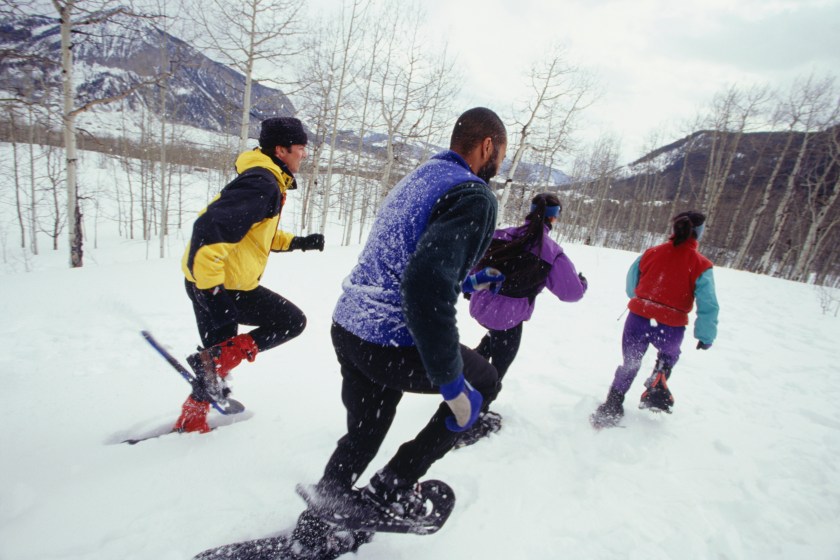
Getty Images, Steve Mason
On top of having the right snowshoes for your adventure, you must have the right outfit. Of course, your apparel will depend on the snow conditions and where you live. I've gone snowshoeing with active snowfall, requiring all the layers. Outings in the early spring with deep snow and warmer temperatures may need less. With my area's last season's late, heavy snow, I could snowshoe into early May in temperatures in the 40s and a bright, shining sun. While 40 degrees may not seem warm, the full sun and high activity level had us all shedding our layers as we heated up. The kids ended up in T-shirts with long pants, and I was in a tank top with snow pants, regretting the snow pants the whole time.
But assessing the weather is all a part of planning your snowshoeing adventure, and it's better to have all the layers you may need than not to be warm enough. These include:
- Base layers made of wool or synthetic fabric that fit close to the skin
- Mid-layers of fleece or wool to offer insulation
- Waterproof, windproof outer layers, i.e., a ski jacket and snow pants
- Mittens, beanie, and scarf or neck gaiter
- Sunglasses to protect eyes from glare
- Winter boots with hiking socks
- Gaiters (if your boots don't keep snow out on their own)
- Sunscreen to protect exposed sun from UV radiation
Always pack plenty of water, snacks, a first aid kit, and other hiking essentials. If you're heading into a remote area, you should also consider a satellite communicator or phone.
Beginner Snowshoeing Tips
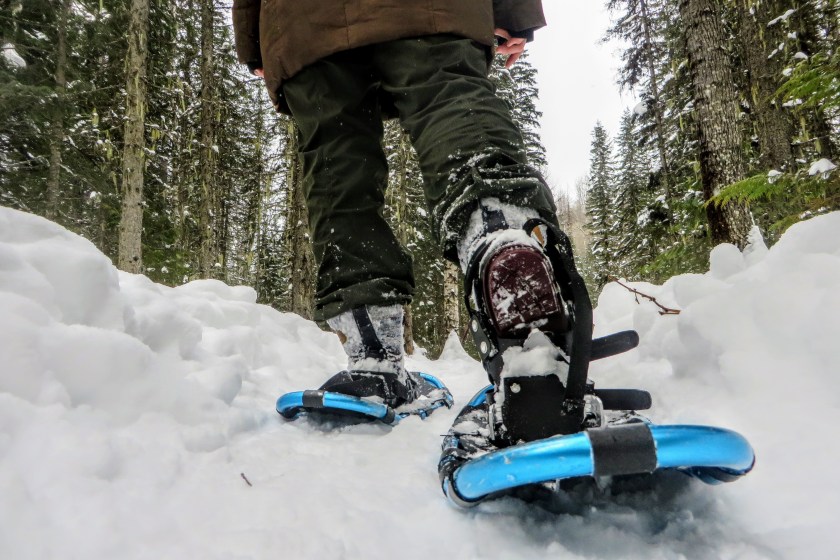
Getty Images, Chris Babcock
Getting started snowshoeing isn't a difficult undertaking, which is why folks of all ages enjoy the activity. Even kids can don a pair of snowshoes and head out, which my four- and nine-year-olds do. However, I have a few tips that can help get you started:
- Keep your legs parallel. The last thing you want to do is accidentally cross your snowshoes in the front or the back. It's the fastest way to trip and fall (though at least snow provides a soft landing). I crossed mine several times my first time out and was thankful I had trekking poles to keep me upright.
- Lift legs high. Only the front of your foot is strapped to the snowshoe, so when you go to turn, the back is loose. You have to lift your leg up high in the air while rotating on sharp turns, or the rear of the deck can get stuck in the snow. If you catch the rear deck, you may also fall.
- Watch out for sharp edges. Some crampons are very sharp. Ours aren't sharp enough to cut your finger but could give you a scratch. But with some brands, especially those made for expeditions, you may need a band-aid or two if the metal comes in contact with your skin.
Types of Snowshoeing Trips
- Recreational snowshoeing is pretty much what it sounds like, and is what most beginners will start with. Trails typically have flat terrain and outings are easy paced.
- Sport snowshoeing is excellent exercise that can build muscle and help people lose weight. More experienced snowshoers may prefer sport snowshoeing, in which you take on harder terrain and steeper trails.
- Expedition snowshoeing is for elite shoeshoers who tackle backcountry terrain, scaling mountains and traversing remote trails. Snowshoers at this level need avalanche training, carry safety kits, and invest in high-quality winter gear and top-of-the-line snowshoes.
